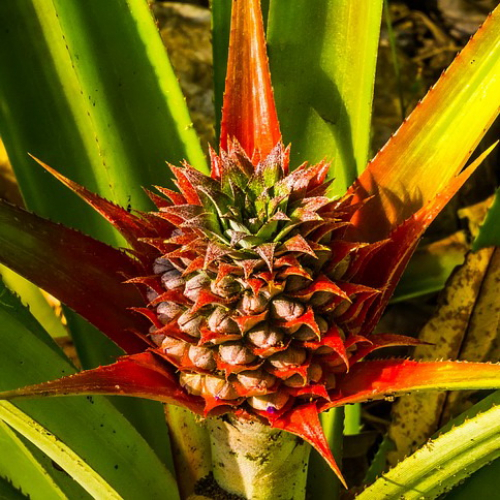Indoor plants Ananas

Description
Characteristic Features of Ananas
Ananas is a genus of herbaceous tropical plants in the bromeliad family Bromeliaceae comprising 8 or 9 species. They are indigenous to the tropical area of South America, from 10 degrees north latitude down to Paraguay and Argentina in the south.
Dry Brazilian Highlands in the central part of this vast country is home to Ananas comosus (or Ananasa Sativa, Ananas sativus, Bromelia ananas, Bromelia comosa, and Champaca) also commonly known as Pineapple. All currently known varieties of food and dessert pineapples originated from this species. Members of Ferdinand Magellan's expedition during the First Circumnavigation of the World in 1519-1522 who tried this ripe fragrant fruit, called it "the most delicious that you can find anywhere in the world". Soon the Portuguese introduced it into tropical plantations in India and Africa. Since the mid-17th century, the overseas curiosity started to be cultivated in greenhouses in Europe, even in the suburbs of St. Petersburg.
The Russian literature has always treated Pineapple solely as food of the upper class society. Remember Igor Severyanin ("Pineapples in champagne! Deliriously tasty ...") or Vladimir Mayakovsky ("Eat pineapples, chew on your grouse. Your last day is coming, your bourgeois louse! "on behalf of the revolutionary proletariat or "Clearly, the white pineapple - Oh Lord! - was grown not for us ..."(on behalf of a Ryazan peasant)). Currently, many resources emphasise extraordinary benefit of including Pineapple in the form of juices and / or slices into the diet due to potent biologically active substances.
This massive gastronomic interest somehow intercepts the fact that Pineapple is also cultivated as an ornamental houseplant with attractive foliage and spike-like inflorescences (while excessive eating of "bourgeois goodies" damages the mucous membrane of the mouth).
An ornamental Pineapple has fleshy and juicy succulent (i.e. storing up moisture) leaves up to 1 meter long, with sharp spines on the edges, green or grey green, with a pinkish hue or yellow or white margins. There are variegated forms (for example, Ananas comosus var. Variegate has white striped foliage). Some cultivars have sharply serrated leaves 35 to 70 centimeters long. Variety Aureovariegatus has pink spines.
Flowering takes place in February-April. If it is sufficiently warm and moist, the fruit may develop from the inflorescence in the summer and autumn but it is not good for eating.
Ananas comosus produces a golden yellow fruit topped with a tuft of vegetative leaves; Ananas bracteatus tricolour produces a fruit that is rich pink.
The Secrets to Successfully Growing Ananas
The plant requires: a) a lot of bright filtered light; and b) protection from direct sunlight, especially for variegated forms.
Ananas prefers moderate watering with soft water and likes regular misting, especially if located in a very warm place. Some experts advise watering plentifully with settled water during the growing season from April to September. If the room is cool, do not allow water to get into the sinuses and stand there, otherwise the plant can die of rot.
In the summer, the best temperatures are 18-25 ° C and 15-19 ° C in the winter.
Every 10-15 days fertilize your plant with liquid compound fertilizer and thoroughly strained horse or cow manure solution. Once or twice a month make sure to mist and water with the acidified solution of iron sulphate FeSO4 (1 g per 1 liter of water). Drip the solution in the sinuses of upper leaves to stimulate flowering. For the same purpose, commercial fruit producers use acetylene gas C2H2 generated by wetting of calcium carbide CaC2. This helps to get pineapples on the plantations continuously all year round. Avoid alkaline fertilizers (wood ash, lime, etc.) because the plant can not withstand alkaline.
Repot Ananas every year or every two years from the spring to autumn. The plant does not require a big pot for it has relatively little roots. A 3-4 liter pot is sufficient even for a mature plant. Repot very carefully as the root ball should be disturbed as little as possible. Root collar should be planted 0.5 centimeters deep. The soil should be loose, nutritious, and slightly acidic (pH 4-6).
Recommended composition is loam, peat, and sand at 1:1:1. You can replace the first ingredient with old rotted manure.
In indoor cultivation, vegetative propagation is the dominant form of reproduction by the use of vegetative shoots including the crown, slips, and suckers. Cut the crown off a fully ripened fruit using a clean sharp knife or carefully break out the shoots 15-20 centimeters long. Further steps are well-known, simple, and similar for most plants.
Ananas does not need regular pruning. Just delete the damaged or dried up parts of the leaves with sharp scissors, without affecting healthy tissue.
Clean the leaves from dust with a soft cloth, then wipe with a sponge soaked in water at room temperature. Do not use leaf gloss.
Potential Problems
If the leaf tips dry up, the air is too dry.
If there are spots on the leaves, the soil is waterlogged.
If the plant rots at the base, the reason again is waterlogging and / or low temperatures.
If the foliage loses colour, the light is insufficient.
If the leaves dry out and curl, the likely reason is the drafts. Place the pot into a different location.
If your plant grows slowly and does not bloom, it probably lacks food.
Ananas infrequently gets diseases or pests, as compared with other indoor fruit-bearing plants. The most common enemy is soft scale (Coccidae), with about 150 species found in Europe. Scale insects and mealybugs (330 species in Europe) are also common.
Ananas is not poisonous but can cause contact dermatitis. Wear gloves when handling the plant. This will also protects from sharp edges. Lots of resources unanimously claim that "Pineapple cultivated indoors rarely blooms and bears fruit." Fancy trying to disprove the pessimists?







 334
334






